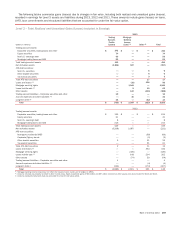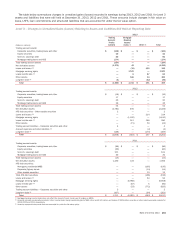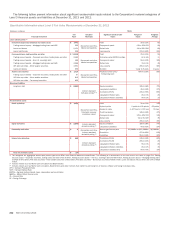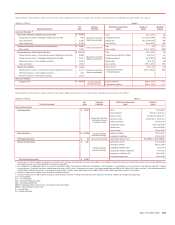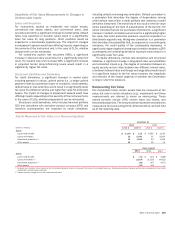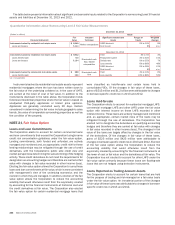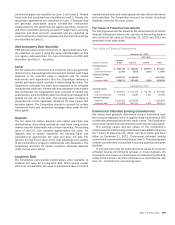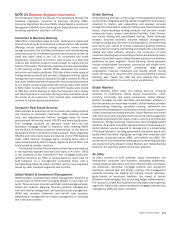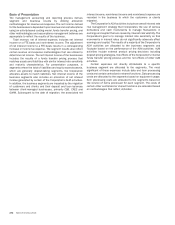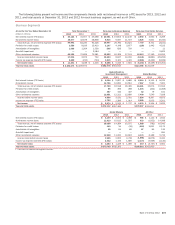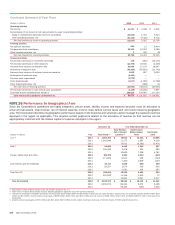Bank of America 2013 Annual Report Download - page 268
Download and view the complete annual report
Please find page 268 of the 2013 Bank of America annual report below. You can navigate through the pages in the report by either clicking on the pages listed below, or by using the keyword search tool below to find specific information within the annual report.
266 Bank of America 2013
The table below presents information about significant unobservable inputs related to the Corporation’s nonrecurring Level 3 financial
assets and liabilities at December 31, 2013 and 2012.
Quantitative Information about Nonrecurring Level 3 Fair Value Measurements
December 31, 2013
(Dollars in millions) Inputs
Financial Instrument
Fair
Value
Valuation
Technique
Significant Unobservable
Inputs
Ranges of
Inputs
Weighted
Average
Instruments backed by residential real estate assets $ 5,240 Market comparables OREO discount 0% to 19% 8%
Loans and leases 5,240 Cost to sell 8% n/a
December 31, 2012
Instruments backed by residential real estate assets $ 9,932
Discounted cash
flow, Market
comparables
Yield 3% to 5% 3%
Loans held-for-sale 748 Prepayment speed 3% to 30% 15%
Loans and leases 9,184 Default rate 0% to 55% 7%
Loss severity 6% to 66% 48%
OREO discount 0% to 28% 15%
Cost to sell 8% n/a
Instruments backed by commercial real estate assets $ 388 Discounted cash
flow
Yield 4% to 13% 6%
Loans held-for-sale 388 Loss severity 24% to 88% 53%
n/a = not applicable
Instruments backed by residential real estate assets represent
residential mortgages where the loan has been written down to
the fair value of the underlying collateral or, in the case of LHFS,
are carried at the lower of cost or fair value. In addition to the
instruments disclosed in the table above, the Corporation holds
foreclosed residential properties where the fair value is based on
unadjusted third-party appraisals or broker price opinions.
Appraisals are generally conducted every 90 days. Factors
considered in determining the fair value include geographic sales
trends, the value of comparable surrounding properties as well as
the condition of the property.
NOTE 21 Fair Value Option
Loans and Loan Commitments
The Corporation elects to account for certain commercial loans
and loan commitments that exceed the Corporation’s single name
credit risk concentration guidelines under the fair value option.
Lending commitments, both funded and unfunded, are actively
managed and monitored and, as appropriate, credit risk for these
lending relationships may be mitigated through the use of credit
derivatives, with the Corporation’s public side credit view and
market perspectives determining the size and timing of the hedging
activity. These credit derivatives do not meet the requirements for
designation as accounting hedges and therefore are carried at fair
value with changes in fair value recorded in other income (loss).
Electing the fair value option allows the Corporation to carry these
loans and loan commitments at fair value, which is more consistent
with management’s view of the underlying economics and the
manner in which they are managed. In addition, election of the fair
value option allows the Corporation to reduce the accounting
volatility that would otherwise result from the asymmetry created
by accounting for the financial instruments at historical cost and
the credit derivatives at fair value. The Corporation also elected
the fair value option for certain residential mortgage loans that
were classified as held-for-sale and certain loans held in
consolidated VIEs. Of the changes in fair value of these loans,
gains of $315 million and $1.2 billion were attributable to changes
in borrower-specific credit risk in 2013 and 2012.
Loans Held-for-sale
The Corporation elects to account for residential mortgage LHFS,
commercial mortgage LHFS and other LHFS under the fair value
option with interest income on these LHFS recorded in other
interest income. These loans are actively managed and monitored
and, as appropriate, certain market risks of the loans may be
mitigated through the use of derivatives. The Corporation has
elected not to designate the derivatives as qualifying accounting
hedges and therefore they are carried at fair value with changes
in fair value recorded in other income (loss). The changes in fair
value of the loans are largely offset by changes in the fair value
of the derivatives. Of the changes in fair value of these loans,
gains of $225 million and $425 million were attributable to
changes in borrower-specific credit risk in 2013 and 2012. Election
of the fair value option allows the Corporation to reduce the
accounting volatility that would otherwise result from the
asymmetry created by accounting for the financial instruments at
the lower of cost or fair value and the derivatives at fair value. The
Corporation has not elected to account for other LHFS under the
fair value option primarily because these loans are floating-rate
loans that are not hedged using derivative instruments.
Loans Reported as Trading Account Assets
The Corporation elects to account for certain loans that are held
for the purpose of trading and risk-managed on a fair value basis
under the fair value option. An immaterial portion of the changes
in fair value of these loans was attributable to changes in borrower-
specific credit risk in 2013 and 2012.





